Brand Positioning and Millennial Post-Purchase Behavior: UK Fashion
VerifiedAdded on 2020/12/03
|12
|2939
|88
Project
AI Summary
This research proposal investigates the influence of brand positioning on the post-purchase behavior and feelings of UK-based millennials within the digital retail environment, specifically focusing on fashion garments. The introduction establishes the significance of millennials as a key consumer group and highlights the need for brands to understand their preferences. The study aims to identify the determinants of brand influence on consumer choices and analyze the strategies employed by fashion brands in the context of fast fashion. The literature review explores the fashion industry, the digital age, and provides a case study of Zara, examining its e-commerce strategy, technological integration, and market dominance. The methodology section outlines the research approach, data collection methods, and sampling techniques used to gather insights into millennial brand loyalty and consumer behavior. The research questions address factors that enhance brand identity, the fashion industry's response to fast fashion, and brand loyalty among millennials.
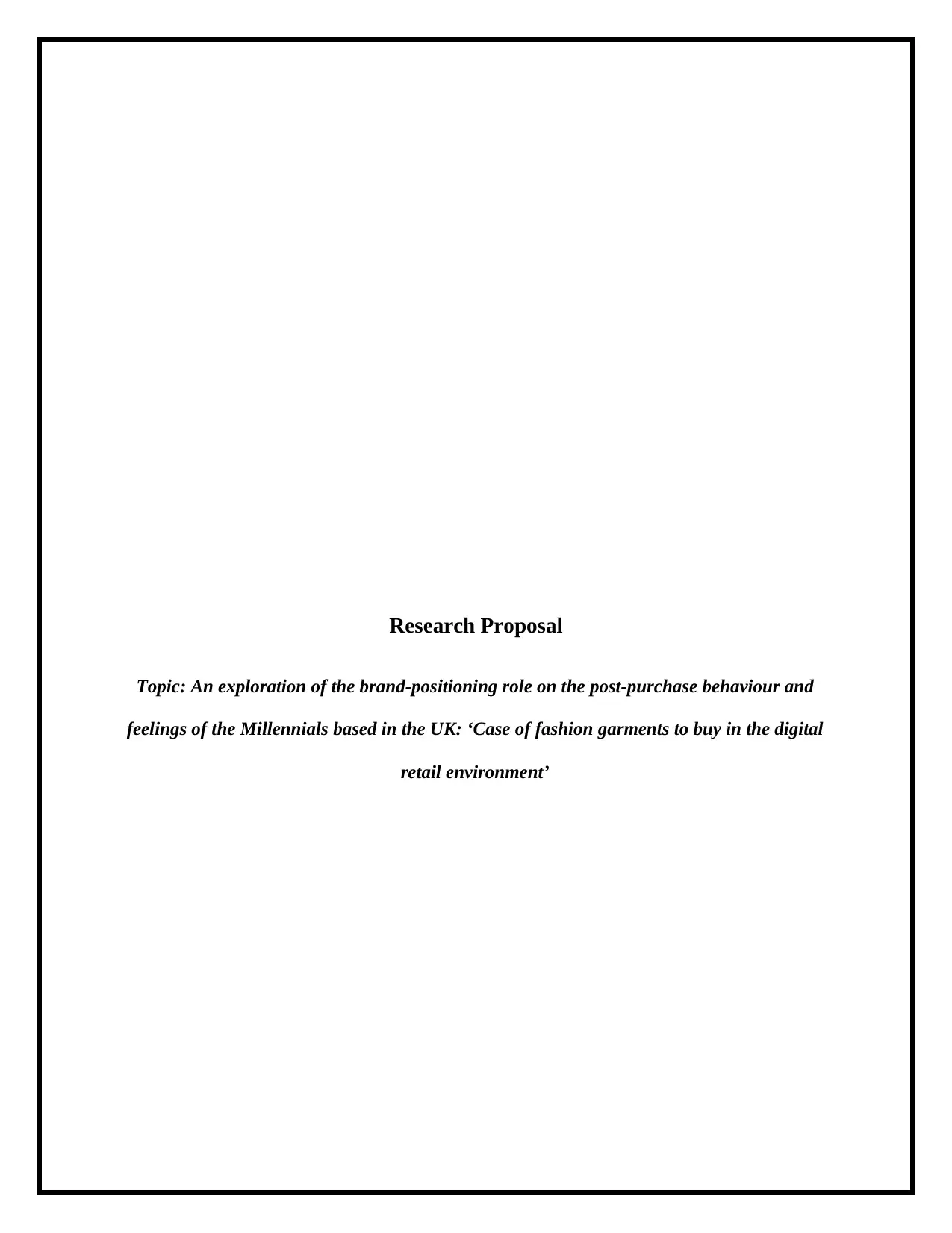
Research Proposal
Topic: An exploration of the brand-positioning role on the post-purchase behaviour and
feelings of the Millennials based in the UK: ‘Case of fashion garments to buy in the digital
retail environment’
Topic: An exploration of the brand-positioning role on the post-purchase behaviour and
feelings of the Millennials based in the UK: ‘Case of fashion garments to buy in the digital
retail environment’
Paraphrase This Document
Need a fresh take? Get an instant paraphrase of this document with our AI Paraphraser
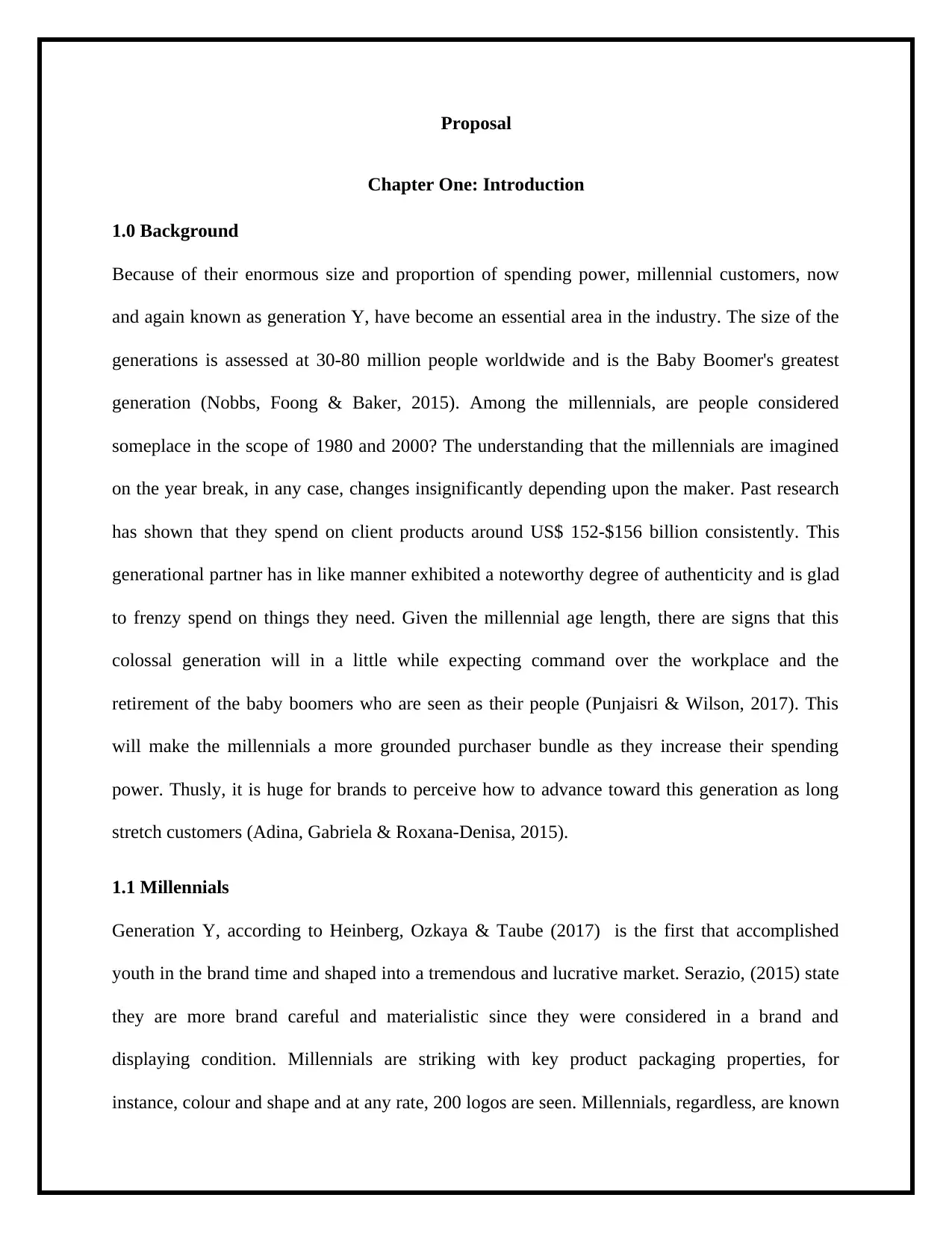
Proposal
Chapter One: Introduction
1.0 Background
Because of their enormous size and proportion of spending power, millennial customers, now
and again known as generation Y, have become an essential area in the industry. The size of the
generations is assessed at 30-80 million people worldwide and is the Baby Boomer's greatest
generation (Nobbs, Foong & Baker, 2015). Among the millennials, are people considered
someplace in the scope of 1980 and 2000? The understanding that the millennials are imagined
on the year break, in any case, changes insignificantly depending upon the maker. Past research
has shown that they spend on client products around US$ 152-$156 billion consistently. This
generational partner has in like manner exhibited a noteworthy degree of authenticity and is glad
to frenzy spend on things they need. Given the millennial age length, there are signs that this
colossal generation will in a little while expecting command over the workplace and the
retirement of the baby boomers who are seen as their people (Punjaisri & Wilson, 2017). This
will make the millennials a more grounded purchaser bundle as they increase their spending
power. Thusly, it is huge for brands to perceive how to advance toward this generation as long
stretch customers (Adina, Gabriela & Roxana-Denisa, 2015).
1.1 Millennials
Generation Y, according to Heinberg, Ozkaya & Taube (2017) is the first that accomplished
youth in the brand time and shaped into a tremendous and lucrative market. Serazio, (2015) state
they are more brand careful and materialistic since they were considered in a brand and
displaying condition. Millennials are striking with key product packaging properties, for
instance, colour and shape and at any rate, 200 logos are seen. Millennials, regardless, are known
Chapter One: Introduction
1.0 Background
Because of their enormous size and proportion of spending power, millennial customers, now
and again known as generation Y, have become an essential area in the industry. The size of the
generations is assessed at 30-80 million people worldwide and is the Baby Boomer's greatest
generation (Nobbs, Foong & Baker, 2015). Among the millennials, are people considered
someplace in the scope of 1980 and 2000? The understanding that the millennials are imagined
on the year break, in any case, changes insignificantly depending upon the maker. Past research
has shown that they spend on client products around US$ 152-$156 billion consistently. This
generational partner has in like manner exhibited a noteworthy degree of authenticity and is glad
to frenzy spend on things they need. Given the millennial age length, there are signs that this
colossal generation will in a little while expecting command over the workplace and the
retirement of the baby boomers who are seen as their people (Punjaisri & Wilson, 2017). This
will make the millennials a more grounded purchaser bundle as they increase their spending
power. Thusly, it is huge for brands to perceive how to advance toward this generation as long
stretch customers (Adina, Gabriela & Roxana-Denisa, 2015).
1.1 Millennials
Generation Y, according to Heinberg, Ozkaya & Taube (2017) is the first that accomplished
youth in the brand time and shaped into a tremendous and lucrative market. Serazio, (2015) state
they are more brand careful and materialistic since they were considered in a brand and
displaying condition. Millennials are striking with key product packaging properties, for
instance, colour and shape and at any rate, 200 logos are seen. Millennials, regardless, are known
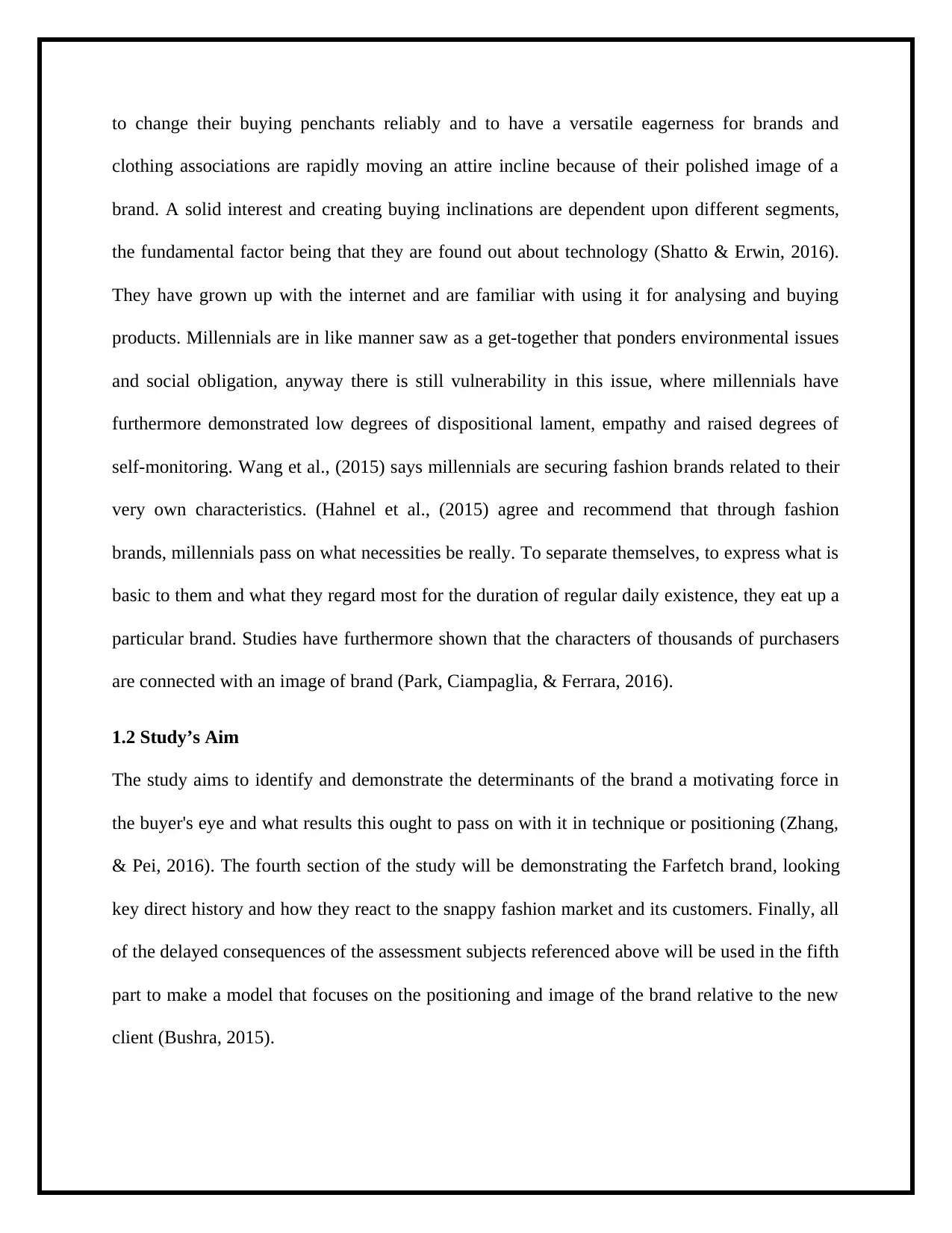
to change their buying penchants reliably and to have a versatile eagerness for brands and
clothing associations are rapidly moving an attire incline because of their polished image of a
brand. A solid interest and creating buying inclinations are dependent upon different segments,
the fundamental factor being that they are found out about technology (Shatto & Erwin, 2016).
They have grown up with the internet and are familiar with using it for analysing and buying
products. Millennials are in like manner saw as a get-together that ponders environmental issues
and social obligation, anyway there is still vulnerability in this issue, where millennials have
furthermore demonstrated low degrees of dispositional lament, empathy and raised degrees of
self-monitoring. Wang et al., (2015) says millennials are securing fashion brands related to their
very own characteristics. (Hahnel et al., (2015) agree and recommend that through fashion
brands, millennials pass on what necessities be really. To separate themselves, to express what is
basic to them and what they regard most for the duration of regular daily existence, they eat up a
particular brand. Studies have furthermore shown that the characters of thousands of purchasers
are connected with an image of brand (Park, Ciampaglia, & Ferrara, 2016).
1.2 Study’s Aim
The study aims to identify and demonstrate the determinants of the brand a motivating force in
the buyer's eye and what results this ought to pass on with it in technique or positioning (Zhang,
& Pei, 2016). The fourth section of the study will be demonstrating the Farfetch brand, looking
key direct history and how they react to the snappy fashion market and its customers. Finally, all
of the delayed consequences of the assessment subjects referenced above will be used in the fifth
part to make a model that focuses on the positioning and image of the brand relative to the new
client (Bushra, 2015).
clothing associations are rapidly moving an attire incline because of their polished image of a
brand. A solid interest and creating buying inclinations are dependent upon different segments,
the fundamental factor being that they are found out about technology (Shatto & Erwin, 2016).
They have grown up with the internet and are familiar with using it for analysing and buying
products. Millennials are in like manner saw as a get-together that ponders environmental issues
and social obligation, anyway there is still vulnerability in this issue, where millennials have
furthermore demonstrated low degrees of dispositional lament, empathy and raised degrees of
self-monitoring. Wang et al., (2015) says millennials are securing fashion brands related to their
very own characteristics. (Hahnel et al., (2015) agree and recommend that through fashion
brands, millennials pass on what necessities be really. To separate themselves, to express what is
basic to them and what they regard most for the duration of regular daily existence, they eat up a
particular brand. Studies have furthermore shown that the characters of thousands of purchasers
are connected with an image of brand (Park, Ciampaglia, & Ferrara, 2016).
1.2 Study’s Aim
The study aims to identify and demonstrate the determinants of the brand a motivating force in
the buyer's eye and what results this ought to pass on with it in technique or positioning (Zhang,
& Pei, 2016). The fourth section of the study will be demonstrating the Farfetch brand, looking
key direct history and how they react to the snappy fashion market and its customers. Finally, all
of the delayed consequences of the assessment subjects referenced above will be used in the fifth
part to make a model that focuses on the positioning and image of the brand relative to the new
client (Bushra, 2015).
⊘ This is a preview!⊘
Do you want full access?
Subscribe today to unlock all pages.

Trusted by 1+ million students worldwide

1.3 Purpose of the study
The study focuses on integrating the image and trustworthy of the brand that lacks in the research
and the difficulty of understanding of millennial, the explanation behind this assessment is to
perceive the activity of brand character and overhaul the commonality with millennials brand
trustworthiness concerning fashion brands (Sudha & Sheena, 2017).
1.4 Research questions
1. Which factors are crucial for enhancing the identity and image of the brand in the context
of the fashion industry that should be assessed for enhancing the brand perception and
buying power of the customer?
2. How did fashion brands deal with the present conditions of the environment of fast
fashion? Were millennials in the fashion industry loyal to brands?
1.5 Objective
The goal of this study is to clarify the purchasing behaviour of the current apparel customer to
direct brand repositioning in the new market climate (Papahristou, & Bilalis, 2017).
The study focuses on integrating the image and trustworthy of the brand that lacks in the research
and the difficulty of understanding of millennial, the explanation behind this assessment is to
perceive the activity of brand character and overhaul the commonality with millennials brand
trustworthiness concerning fashion brands (Sudha & Sheena, 2017).
1.4 Research questions
1. Which factors are crucial for enhancing the identity and image of the brand in the context
of the fashion industry that should be assessed for enhancing the brand perception and
buying power of the customer?
2. How did fashion brands deal with the present conditions of the environment of fast
fashion? Were millennials in the fashion industry loyal to brands?
1.5 Objective
The goal of this study is to clarify the purchasing behaviour of the current apparel customer to
direct brand repositioning in the new market climate (Papahristou, & Bilalis, 2017).
Paraphrase This Document
Need a fresh take? Get an instant paraphrase of this document with our AI Paraphraser
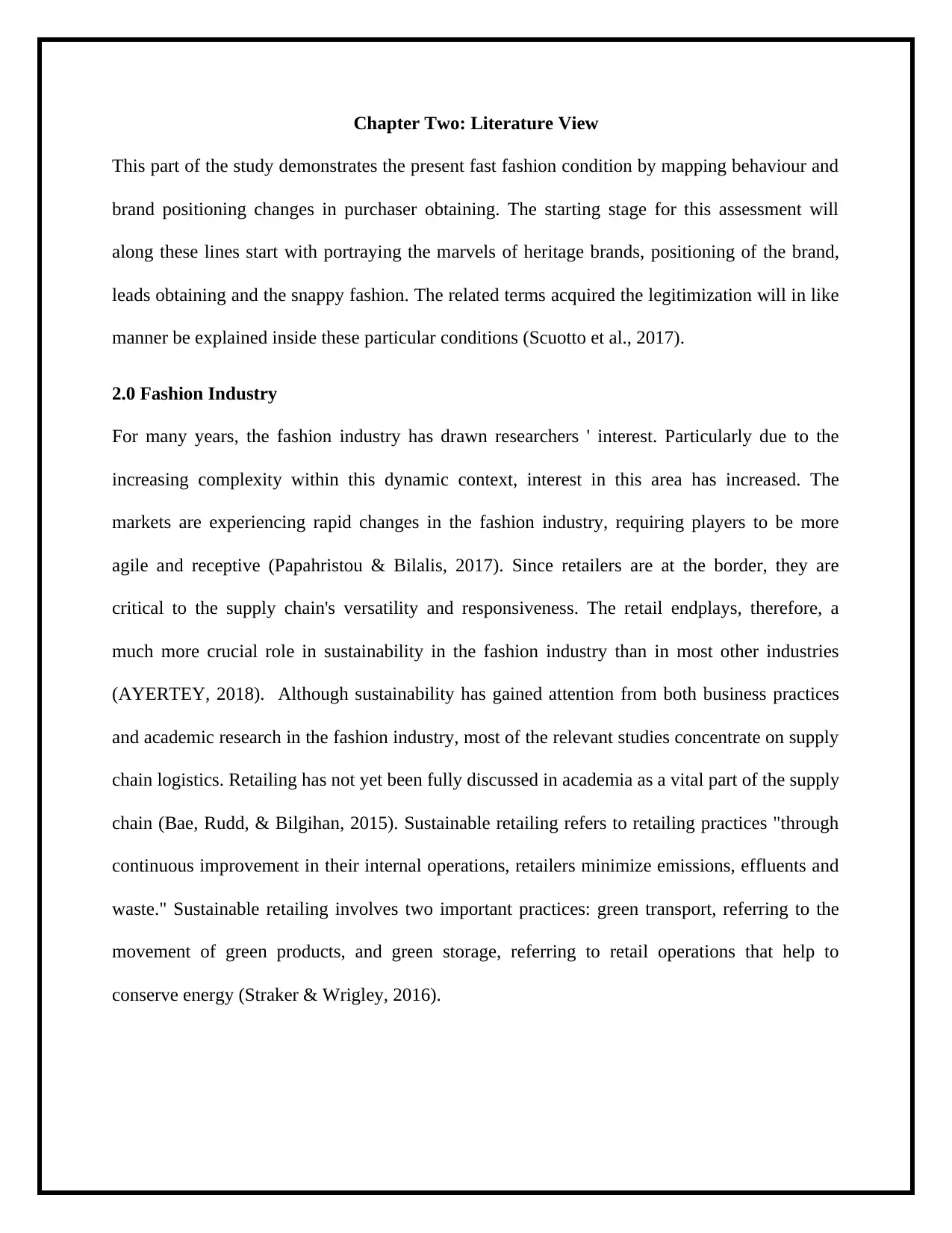
Chapter Two: Literature View
This part of the study demonstrates the present fast fashion condition by mapping behaviour and
brand positioning changes in purchaser obtaining. The starting stage for this assessment will
along these lines start with portraying the marvels of heritage brands, positioning of the brand,
leads obtaining and the snappy fashion. The related terms acquired the legitimization will in like
manner be explained inside these particular conditions (Scuotto et al., 2017).
2.0 Fashion Industry
For many years, the fashion industry has drawn researchers ' interest. Particularly due to the
increasing complexity within this dynamic context, interest in this area has increased. The
markets are experiencing rapid changes in the fashion industry, requiring players to be more
agile and receptive (Papahristou & Bilalis, 2017). Since retailers are at the border, they are
critical to the supply chain's versatility and responsiveness. The retail endplays, therefore, a
much more crucial role in sustainability in the fashion industry than in most other industries
(AYERTEY, 2018). Although sustainability has gained attention from both business practices
and academic research in the fashion industry, most of the relevant studies concentrate on supply
chain logistics. Retailing has not yet been fully discussed in academia as a vital part of the supply
chain (Bae, Rudd, & Bilgihan, 2015). Sustainable retailing refers to retailing practices "through
continuous improvement in their internal operations, retailers minimize emissions, effluents and
waste." Sustainable retailing involves two important practices: green transport, referring to the
movement of green products, and green storage, referring to retail operations that help to
conserve energy (Straker & Wrigley, 2016).
This part of the study demonstrates the present fast fashion condition by mapping behaviour and
brand positioning changes in purchaser obtaining. The starting stage for this assessment will
along these lines start with portraying the marvels of heritage brands, positioning of the brand,
leads obtaining and the snappy fashion. The related terms acquired the legitimization will in like
manner be explained inside these particular conditions (Scuotto et al., 2017).
2.0 Fashion Industry
For many years, the fashion industry has drawn researchers ' interest. Particularly due to the
increasing complexity within this dynamic context, interest in this area has increased. The
markets are experiencing rapid changes in the fashion industry, requiring players to be more
agile and receptive (Papahristou & Bilalis, 2017). Since retailers are at the border, they are
critical to the supply chain's versatility and responsiveness. The retail endplays, therefore, a
much more crucial role in sustainability in the fashion industry than in most other industries
(AYERTEY, 2018). Although sustainability has gained attention from both business practices
and academic research in the fashion industry, most of the relevant studies concentrate on supply
chain logistics. Retailing has not yet been fully discussed in academia as a vital part of the supply
chain (Bae, Rudd, & Bilgihan, 2015). Sustainable retailing refers to retailing practices "through
continuous improvement in their internal operations, retailers minimize emissions, effluents and
waste." Sustainable retailing involves two important practices: green transport, referring to the
movement of green products, and green storage, referring to retail operations that help to
conserve energy (Straker & Wrigley, 2016).

2.1 The digital age
The digital age is where an individual can apply an amazing effect on their lifestyle just as on
their client direct. Kalbaska & Cantoni, (2017). Used "digital local people" to delineate the social
occasions that were raised in the digital age, and "digital pariahs" to portray the ones that
expected to change following live in a digital age. There has been a lot of exchange about these
terms, and it is ordinarily seen as a much-distorted definition. Mannheim's interesting
generational cohort theory in 1928 was also used to portray buyer directly and to explain the
usage of technology this request relies upon shared life stage experiences/events, rather than
progressively standard get-togethers, for instance, social class or land (Caro & Martínez, 2015).
Gen Y and Gen Z are significantly capable digitally, collected and known as the Millennial
Generation. Gen Z is progressively individualistic, more tech-savvy, continuously related, more
brand-conscious than Gen Y (McNeill & Moore, 2015).
2.2 Case Study: Zara fashion brand
It expanded from a small town of Spain to and later to Portugal. Ultimately, by the 1990s, Zara
expanded its business and started to include stores in Europe, France, USA, and France (Mazaira,
Gonzalez & Avendaño, 2003).
Which exactly is the secret to success for Zara? A key reason Zara successfully triggered growth
and rapid international expansion is also one way the brand differs from retail brands. The mark
offers something other people do not do. Shoppers at Zara not only enjoy affordable apparel, but
they also have a non-stop supply of new designs, constantly setting new fashionable clothes to
purchase thanks to Zara's creative e-commerce strategy. It is a trend understood only by Zara
(Ferdows, Lewis, & Machuca, 2003)
The digital age is where an individual can apply an amazing effect on their lifestyle just as on
their client direct. Kalbaska & Cantoni, (2017). Used "digital local people" to delineate the social
occasions that were raised in the digital age, and "digital pariahs" to portray the ones that
expected to change following live in a digital age. There has been a lot of exchange about these
terms, and it is ordinarily seen as a much-distorted definition. Mannheim's interesting
generational cohort theory in 1928 was also used to portray buyer directly and to explain the
usage of technology this request relies upon shared life stage experiences/events, rather than
progressively standard get-togethers, for instance, social class or land (Caro & Martínez, 2015).
Gen Y and Gen Z are significantly capable digitally, collected and known as the Millennial
Generation. Gen Z is progressively individualistic, more tech-savvy, continuously related, more
brand-conscious than Gen Y (McNeill & Moore, 2015).
2.2 Case Study: Zara fashion brand
It expanded from a small town of Spain to and later to Portugal. Ultimately, by the 1990s, Zara
expanded its business and started to include stores in Europe, France, USA, and France (Mazaira,
Gonzalez & Avendaño, 2003).
Which exactly is the secret to success for Zara? A key reason Zara successfully triggered growth
and rapid international expansion is also one way the brand differs from retail brands. The mark
offers something other people do not do. Shoppers at Zara not only enjoy affordable apparel, but
they also have a non-stop supply of new designs, constantly setting new fashionable clothes to
purchase thanks to Zara's creative e-commerce strategy. It is a trend understood only by Zara
(Ferdows, Lewis, & Machuca, 2003)
⊘ This is a preview!⊘
Do you want full access?
Subscribe today to unlock all pages.

Trusted by 1+ million students worldwide
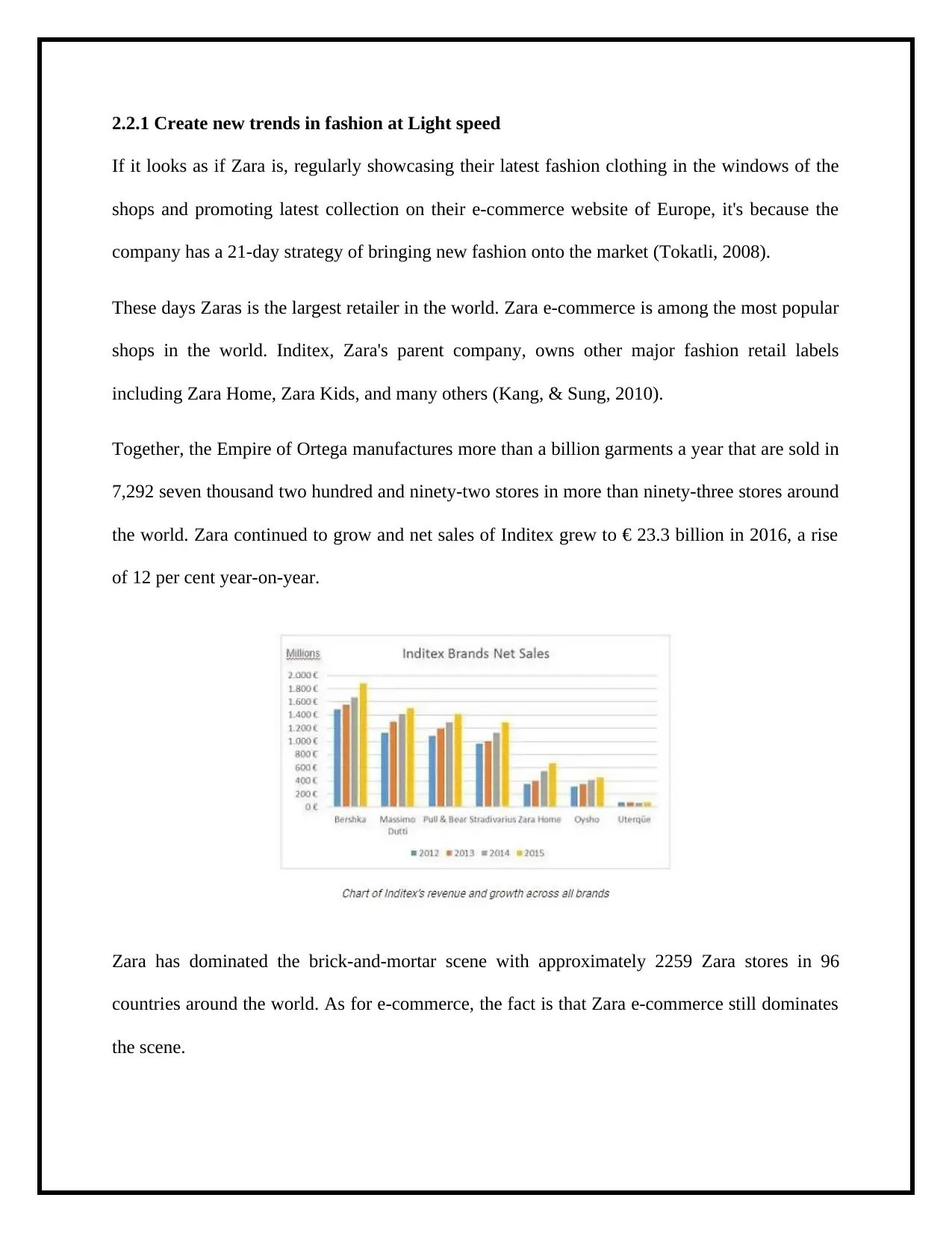
2.2.1 Create new trends in fashion at Light speed
If it looks as if Zara is, regularly showcasing their latest fashion clothing in the windows of the
shops and promoting latest collection on their e-commerce website of Europe, it's because the
company has a 21-day strategy of bringing new fashion onto the market (Tokatli, 2008).
These days Zaras is the largest retailer in the world. Zara e-commerce is among the most popular
shops in the world. Inditex, Zara's parent company, owns other major fashion retail labels
including Zara Home, Zara Kids, and many others (Kang, & Sung, 2010).
Together, the Empire of Ortega manufactures more than a billion garments a year that are sold in
7,292 seven thousand two hundred and ninety-two stores in more than ninety-three stores around
the world. Zara continued to grow and net sales of Inditex grew to € 23.3 billion in 2016, a rise
of 12 per cent year-on-year.
Zara has dominated the brick-and-mortar scene with approximately 2259 Zara stores in 96
countries around the world. As for e-commerce, the fact is that Zara e-commerce still dominates
the scene.
If it looks as if Zara is, regularly showcasing their latest fashion clothing in the windows of the
shops and promoting latest collection on their e-commerce website of Europe, it's because the
company has a 21-day strategy of bringing new fashion onto the market (Tokatli, 2008).
These days Zaras is the largest retailer in the world. Zara e-commerce is among the most popular
shops in the world. Inditex, Zara's parent company, owns other major fashion retail labels
including Zara Home, Zara Kids, and many others (Kang, & Sung, 2010).
Together, the Empire of Ortega manufactures more than a billion garments a year that are sold in
7,292 seven thousand two hundred and ninety-two stores in more than ninety-three stores around
the world. Zara continued to grow and net sales of Inditex grew to € 23.3 billion in 2016, a rise
of 12 per cent year-on-year.
Zara has dominated the brick-and-mortar scene with approximately 2259 Zara stores in 96
countries around the world. As for e-commerce, the fact is that Zara e-commerce still dominates
the scene.
Paraphrase This Document
Need a fresh take? Get an instant paraphrase of this document with our AI Paraphraser

Pablo Isla, the new CEO of Zara, took over Inditex as Chairman in the year 2011. Isla aims to
execute a comprehensive, Omnichannel marketing strategy to improve e-commerce sales of Zara
and reach to conquer fashion online industry.
2.2.2 Stepping into technology RFID
Zara also integrates the latest technology to meet online orders from consumers with stock to
fulfil orders on the same or next day.
This is done using integrated stock management and RFID, that is present in 25 markets in Zara
stores. Indeed, by 2020 Isla recently announced that the integrated stock management system
would be adopted by all countries where stores are present physically. In keeping with the latest
marketing innovations and developments, Inditex revealed in 2018 that it is investing in logistics
robotics, as its brands continue to expand their online presence to reach new markets and have a
growing number of orders to meet (García, 2015).
Naturally, Zara is at the forefront of that progress. The company has begun to explore the
concept of a new store with the help of robots to transport items ordered from nearby warehouses
to consumers (Mazaira, Gonzalez & Avendaño, 2003).
execute a comprehensive, Omnichannel marketing strategy to improve e-commerce sales of Zara
and reach to conquer fashion online industry.
2.2.2 Stepping into technology RFID
Zara also integrates the latest technology to meet online orders from consumers with stock to
fulfil orders on the same or next day.
This is done using integrated stock management and RFID, that is present in 25 markets in Zara
stores. Indeed, by 2020 Isla recently announced that the integrated stock management system
would be adopted by all countries where stores are present physically. In keeping with the latest
marketing innovations and developments, Inditex revealed in 2018 that it is investing in logistics
robotics, as its brands continue to expand their online presence to reach new markets and have a
growing number of orders to meet (García, 2015).
Naturally, Zara is at the forefront of that progress. The company has begun to explore the
concept of a new store with the help of robots to transport items ordered from nearby warehouses
to consumers (Mazaira, Gonzalez & Avendaño, 2003).

Chapter Three: Research Methodology
3.0 Methodology
A description of the methodology of the study will be given in this chapter. It will outline the
research methodology, research method, data acquisition, and sample, and discuss the reliability
and validity of the report.
3.1 Research Approach
A presentation of the study's methodology is given in this chapter. A Data collection was needed
to increase the knowledge about millennials brand loyalty and be able to answer research
questions from the study. Scientific articles and course pieces of literature were used to collect
data from the study. Work can be conducted using a qualitative method according to Mason &
Harrison (2015). A qualitative methodology has been used for the work. The researcher will use
interviews for collecting data. The researcher will conduct interviews of 15 customers. The
sample will be selected according to convenience sampling technique. Thorpe & Gold (2016)
argue that making the data qualitative data is the basic set of a qualitative approach and should
be observable in terms of facts and arguments. A qualitative study appeared more efficient for
this study than a quantitative study because of the amount of previous research, the purpose of
the study to examine the correlation of different variables that affect brand loyalty millennials
(Lanz, 2015).
3.0 Methodology
A description of the methodology of the study will be given in this chapter. It will outline the
research methodology, research method, data acquisition, and sample, and discuss the reliability
and validity of the report.
3.1 Research Approach
A presentation of the study's methodology is given in this chapter. A Data collection was needed
to increase the knowledge about millennials brand loyalty and be able to answer research
questions from the study. Scientific articles and course pieces of literature were used to collect
data from the study. Work can be conducted using a qualitative method according to Mason &
Harrison (2015). A qualitative methodology has been used for the work. The researcher will use
interviews for collecting data. The researcher will conduct interviews of 15 customers. The
sample will be selected according to convenience sampling technique. Thorpe & Gold (2016)
argue that making the data qualitative data is the basic set of a qualitative approach and should
be observable in terms of facts and arguments. A qualitative study appeared more efficient for
this study than a quantitative study because of the amount of previous research, the purpose of
the study to examine the correlation of different variables that affect brand loyalty millennials
(Lanz, 2015).
⊘ This is a preview!⊘
Do you want full access?
Subscribe today to unlock all pages.

Trusted by 1+ million students worldwide
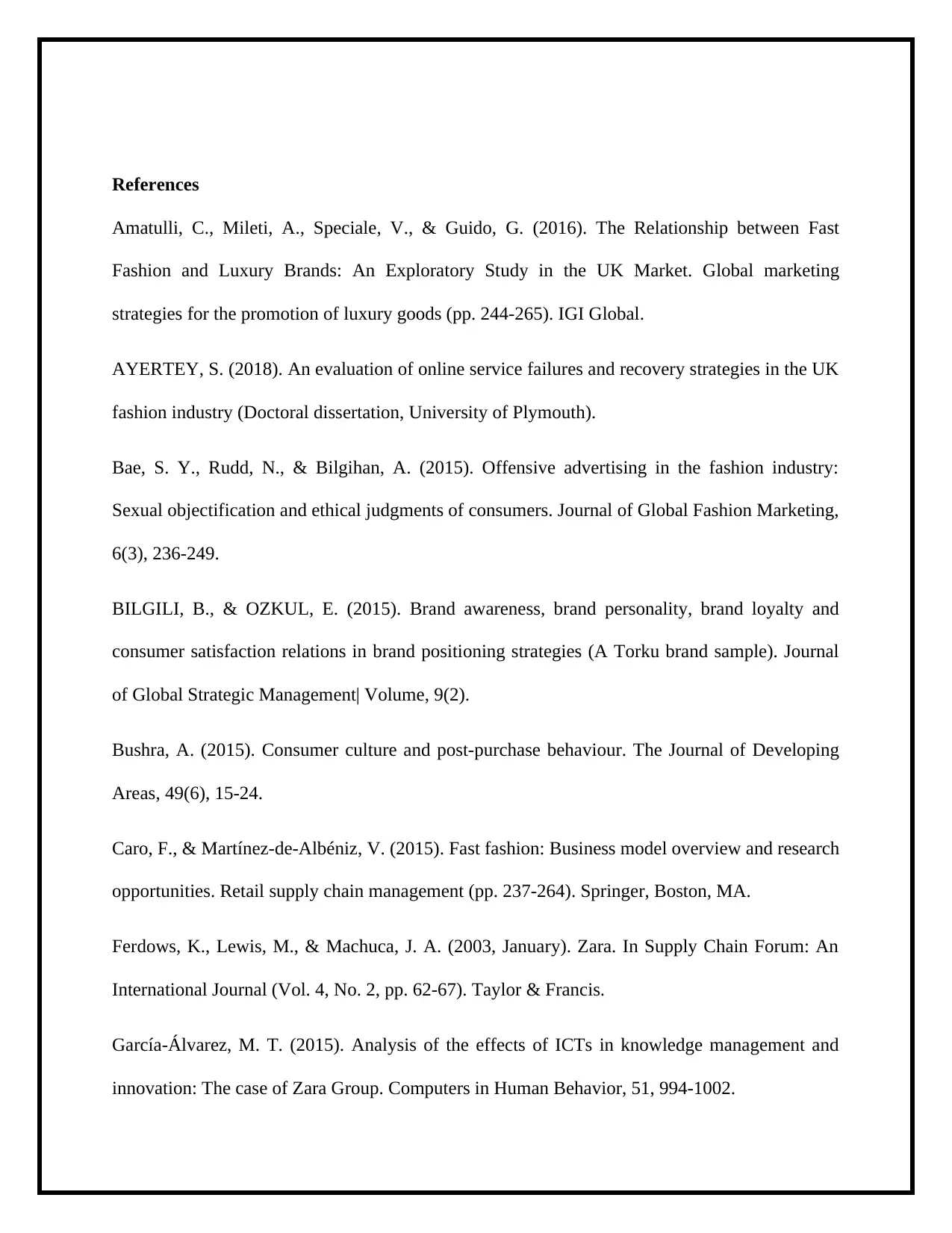
References
Amatulli, C., Mileti, A., Speciale, V., & Guido, G. (2016). The Relationship between Fast
Fashion and Luxury Brands: An Exploratory Study in the UK Market. Global marketing
strategies for the promotion of luxury goods (pp. 244-265). IGI Global.
AYERTEY, S. (2018). An evaluation of online service failures and recovery strategies in the UK
fashion industry (Doctoral dissertation, University of Plymouth).
Bae, S. Y., Rudd, N., & Bilgihan, A. (2015). Offensive advertising in the fashion industry:
Sexual objectification and ethical judgments of consumers. Journal of Global Fashion Marketing,
6(3), 236-249.
BILGILI, B., & OZKUL, E. (2015). Brand awareness, brand personality, brand loyalty and
consumer satisfaction relations in brand positioning strategies (A Torku brand sample). Journal
of Global Strategic Management| Volume, 9(2).
Bushra, A. (2015). Consumer culture and post-purchase behaviour. The Journal of Developing
Areas, 49(6), 15-24.
Caro, F., & Martínez-de-Albéniz, V. (2015). Fast fashion: Business model overview and research
opportunities. Retail supply chain management (pp. 237-264). Springer, Boston, MA.
Ferdows, K., Lewis, M., & Machuca, J. A. (2003, January). Zara. In Supply Chain Forum: An
International Journal (Vol. 4, No. 2, pp. 62-67). Taylor & Francis.
García-Álvarez, M. T. (2015). Analysis of the effects of ICTs in knowledge management and
innovation: The case of Zara Group. Computers in Human Behavior, 51, 994-1002.
Amatulli, C., Mileti, A., Speciale, V., & Guido, G. (2016). The Relationship between Fast
Fashion and Luxury Brands: An Exploratory Study in the UK Market. Global marketing
strategies for the promotion of luxury goods (pp. 244-265). IGI Global.
AYERTEY, S. (2018). An evaluation of online service failures and recovery strategies in the UK
fashion industry (Doctoral dissertation, University of Plymouth).
Bae, S. Y., Rudd, N., & Bilgihan, A. (2015). Offensive advertising in the fashion industry:
Sexual objectification and ethical judgments of consumers. Journal of Global Fashion Marketing,
6(3), 236-249.
BILGILI, B., & OZKUL, E. (2015). Brand awareness, brand personality, brand loyalty and
consumer satisfaction relations in brand positioning strategies (A Torku brand sample). Journal
of Global Strategic Management| Volume, 9(2).
Bushra, A. (2015). Consumer culture and post-purchase behaviour. The Journal of Developing
Areas, 49(6), 15-24.
Caro, F., & Martínez-de-Albéniz, V. (2015). Fast fashion: Business model overview and research
opportunities. Retail supply chain management (pp. 237-264). Springer, Boston, MA.
Ferdows, K., Lewis, M., & Machuca, J. A. (2003, January). Zara. In Supply Chain Forum: An
International Journal (Vol. 4, No. 2, pp. 62-67). Taylor & Francis.
García-Álvarez, M. T. (2015). Analysis of the effects of ICTs in knowledge management and
innovation: The case of Zara Group. Computers in Human Behavior, 51, 994-1002.
Paraphrase This Document
Need a fresh take? Get an instant paraphrase of this document with our AI Paraphraser
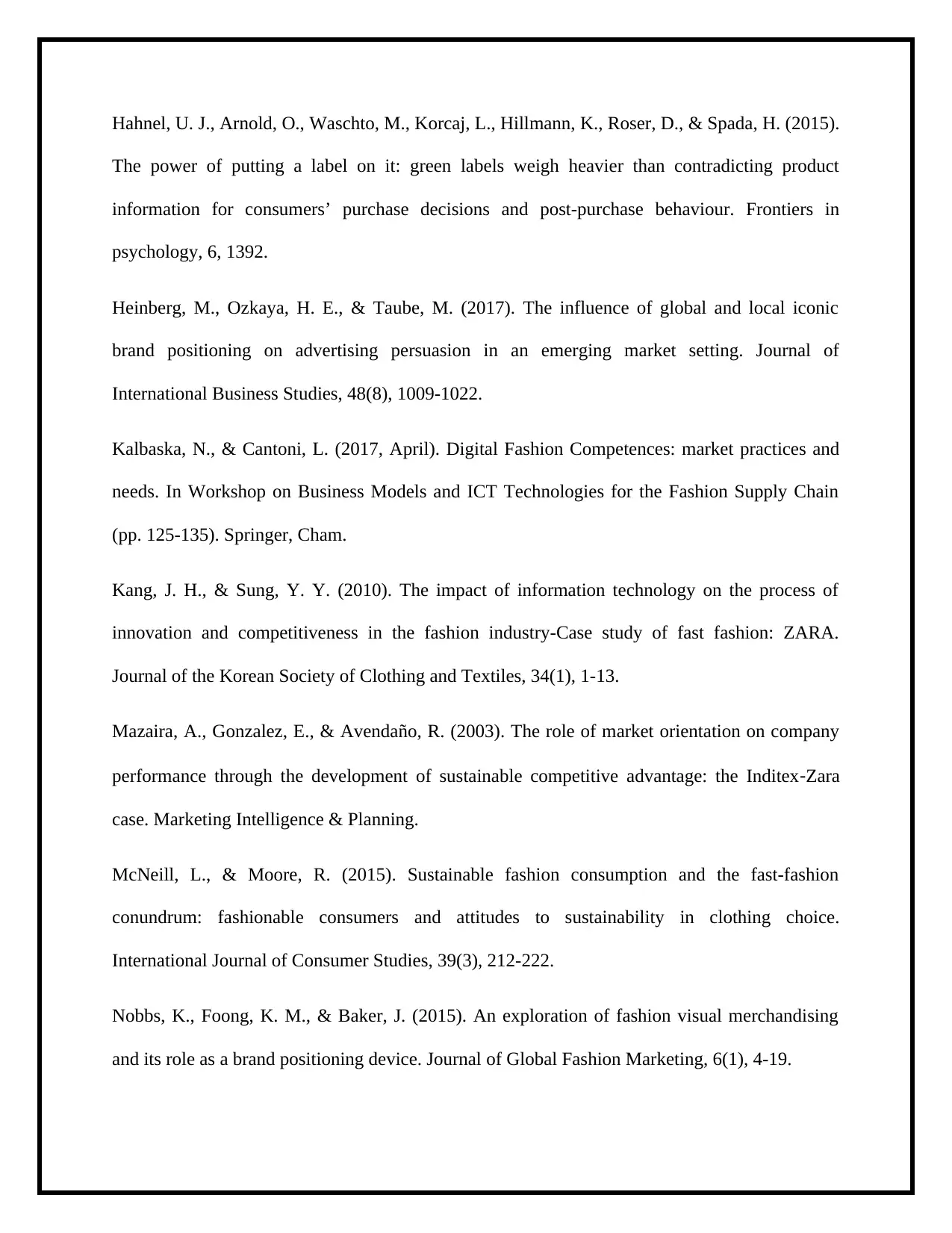
Hahnel, U. J., Arnold, O., Waschto, M., Korcaj, L., Hillmann, K., Roser, D., & Spada, H. (2015).
The power of putting a label on it: green labels weigh heavier than contradicting product
information for consumers’ purchase decisions and post-purchase behaviour. Frontiers in
psychology, 6, 1392.
Heinberg, M., Ozkaya, H. E., & Taube, M. (2017). The influence of global and local iconic
brand positioning on advertising persuasion in an emerging market setting. Journal of
International Business Studies, 48(8), 1009-1022.
Kalbaska, N., & Cantoni, L. (2017, April). Digital Fashion Competences: market practices and
needs. In Workshop on Business Models and ICT Technologies for the Fashion Supply Chain
(pp. 125-135). Springer, Cham.
Kang, J. H., & Sung, Y. Y. (2010). The impact of information technology on the process of
innovation and competitiveness in the fashion industry-Case study of fast fashion: ZARA.
Journal of the Korean Society of Clothing and Textiles, 34(1), 1-13.
Mazaira, A., Gonzalez, E., & Avendaño, R. (2003). The role of market orientation on company
performance through the development of sustainable competitive advantage: the Inditex‐Zara
case. Marketing Intelligence & Planning.
McNeill, L., & Moore, R. (2015). Sustainable fashion consumption and the fast-fashion
conundrum: fashionable consumers and attitudes to sustainability in clothing choice.
International Journal of Consumer Studies, 39(3), 212-222.
Nobbs, K., Foong, K. M., & Baker, J. (2015). An exploration of fashion visual merchandising
and its role as a brand positioning device. Journal of Global Fashion Marketing, 6(1), 4-19.
The power of putting a label on it: green labels weigh heavier than contradicting product
information for consumers’ purchase decisions and post-purchase behaviour. Frontiers in
psychology, 6, 1392.
Heinberg, M., Ozkaya, H. E., & Taube, M. (2017). The influence of global and local iconic
brand positioning on advertising persuasion in an emerging market setting. Journal of
International Business Studies, 48(8), 1009-1022.
Kalbaska, N., & Cantoni, L. (2017, April). Digital Fashion Competences: market practices and
needs. In Workshop on Business Models and ICT Technologies for the Fashion Supply Chain
(pp. 125-135). Springer, Cham.
Kang, J. H., & Sung, Y. Y. (2010). The impact of information technology on the process of
innovation and competitiveness in the fashion industry-Case study of fast fashion: ZARA.
Journal of the Korean Society of Clothing and Textiles, 34(1), 1-13.
Mazaira, A., Gonzalez, E., & Avendaño, R. (2003). The role of market orientation on company
performance through the development of sustainable competitive advantage: the Inditex‐Zara
case. Marketing Intelligence & Planning.
McNeill, L., & Moore, R. (2015). Sustainable fashion consumption and the fast-fashion
conundrum: fashionable consumers and attitudes to sustainability in clothing choice.
International Journal of Consumer Studies, 39(3), 212-222.
Nobbs, K., Foong, K. M., & Baker, J. (2015). An exploration of fashion visual merchandising
and its role as a brand positioning device. Journal of Global Fashion Marketing, 6(1), 4-19.
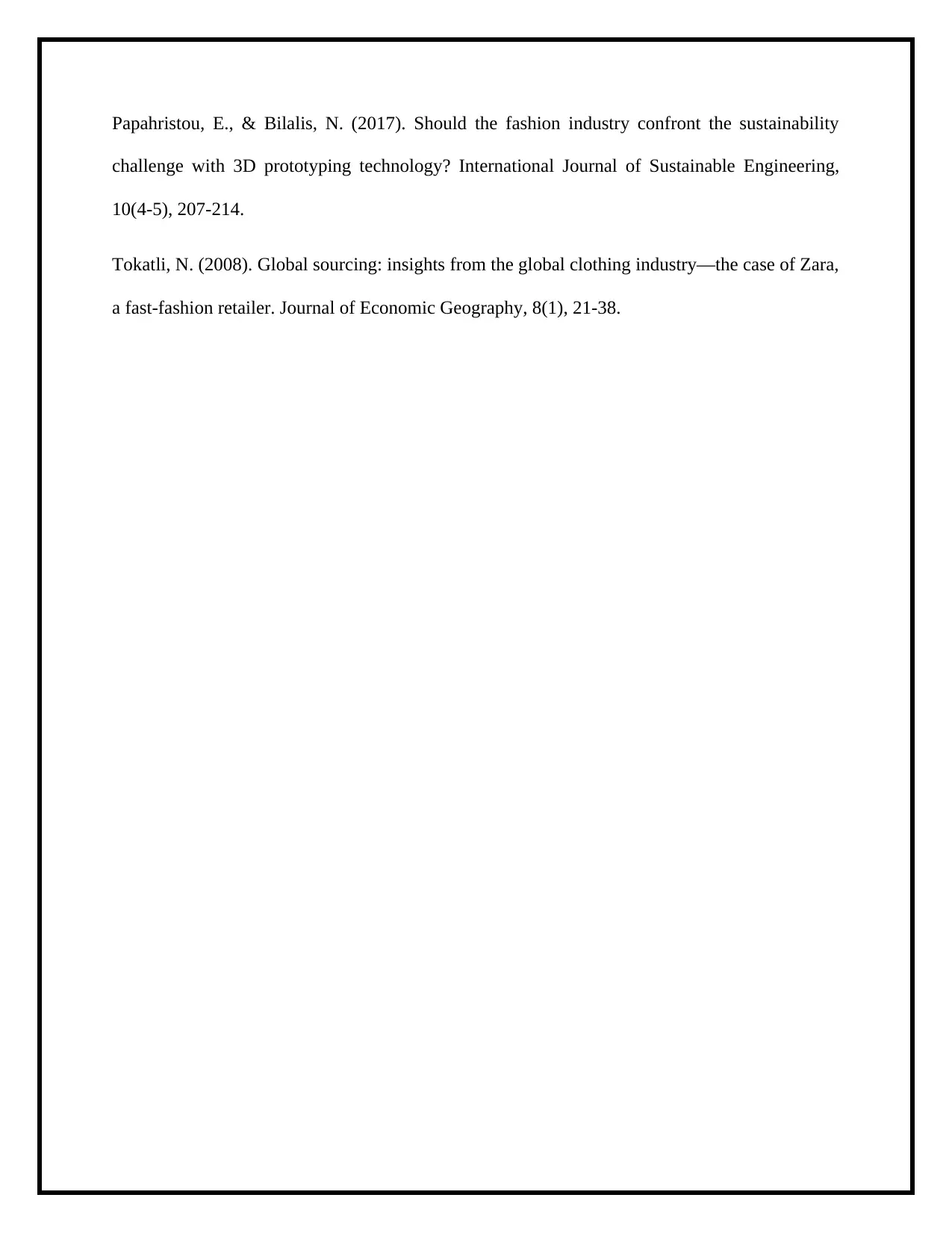
Papahristou, E., & Bilalis, N. (2017). Should the fashion industry confront the sustainability
challenge with 3D prototyping technology? International Journal of Sustainable Engineering,
10(4-5), 207-214.
Tokatli, N. (2008). Global sourcing: insights from the global clothing industry—the case of Zara,
a fast-fashion retailer. Journal of Economic Geography, 8(1), 21-38.
challenge with 3D prototyping technology? International Journal of Sustainable Engineering,
10(4-5), 207-214.
Tokatli, N. (2008). Global sourcing: insights from the global clothing industry—the case of Zara,
a fast-fashion retailer. Journal of Economic Geography, 8(1), 21-38.
⊘ This is a preview!⊘
Do you want full access?
Subscribe today to unlock all pages.

Trusted by 1+ million students worldwide
1 out of 12
Related Documents
Your All-in-One AI-Powered Toolkit for Academic Success.
+13062052269
info@desklib.com
Available 24*7 on WhatsApp / Email
![[object Object]](/_next/static/media/star-bottom.7253800d.svg)
Unlock your academic potential
Copyright © 2020–2025 A2Z Services. All Rights Reserved. Developed and managed by ZUCOL.




